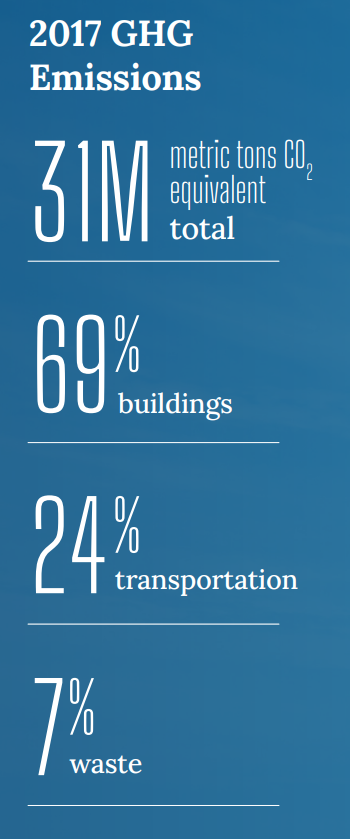Electrify Chicago
According to the
2022 Chicago Climate Action Plan,
a whopping 69% of Chicago's emissions come from buildings, making it
our biggest challenge and our biggest opportunity as a city to tackle
change. At Electrify Chicago we want to showcase some of the best and worst performing
buildings in the city using publicly available data and manual annotations to add
building photographs and label multi-building owners like universities.
You can start by looking at Chicago's buildings with the highest greenhouse gas intensity - this means that they use the most energy when adjusted per unit of square foot, so big buildings could actually perform much better than very inefficient small buildings on this metric.
Legislative update! 🎉
As of late January 2024, legislation is being introduced to require new buildings use more efficient forms of water and space heating, via the Clean And Affordable Buildings Ordinance (CABO), which will reduce the number of highly polluting and inefficient that end up on this site.
If you're in Chicago,
write to your alderman to support the CABO!
Chicago Buildings by Greenhouse Gas Intensity
Note: Data only includes large Chicago buildings from 2021, unless explicitly stated otherwise.
Note: This data only includes buildings whose emissions are reported
under the
Chicago Energy Benchmarking Ordinance. According to the City “As of 2016,
this list includes all commercial, institutional, and residential buildings larger than
50,000 square feet.” This dataset is also then filtered to only buildings with
reported emissions > 1,000 metric tons CO2 equivalent.
This data is also from 2021, but when new benchmark data is available, we'll update the site.
| Property Name / address | Primary Property Type |
Greenhouse Gas Intensity (kg CO2 eq./sqft) |
Total Greenhouse Emissions (metric tons CO2 eq.) |
|---|---|---|---|
|
2731-2739 N Milwaukee Ave
2731 2739 N MILWAUKEE AVE
| Multifamily Housing | 4.5 kg/sqft
Lowest 16%
| 315 tons
Lowest 11%
|
|
Oakwood Shores 2B and 2D Campus
3859 S. Vincennes Avenue
| Multifamily Housing | 4.5 kg/sqft
Lowest 16%
| 892 tons
Highest 49%
|
|
Galvin Library
35 W 33rd Street
| College/University | 4.5 kg/sqft
Lowest 16%
| 419 tons
Lowest 20%
|
|
221 W Hubbard
221 W Hubbard St
| Multifamily Housing | 4.5 kg/sqft
Lowest 16%
| 1,437 tons
Highest 33%
|
|
Midway Pointe Senior Residences
5011 W 47TH ST
| Multifamily Housing | 4.5 kg/sqft
Lowest 16%
| 394 tons
Lowest 17%
|
|
Terra Cotta Commons Condominium
1760 W Wrightwood Ave
| Multifamily Housing | 4.5 kg/sqft
Lowest 16%
| 224 tons
Lowest 4%
|
|
Palmer Square
2128-40 N Kedzie
| Multifamily Housing | 4.5 kg/sqft
Lowest 16%
| 966 tons
Highest 46%
|
|
223 West Erie
223 W Erie St
| Office | 4.5 kg/sqft
Lowest 16%
| 316 tons
Lowest 11%
|
|
North Town Village I
(CHA)
1311 N Halsted
| Multifamily Housing | 4.5 kg/sqft
Lowest 16%
| 461 tons
Lowest 23%
|
|
UIC College Prep
1231 S Damen Ave
| K-12 School | 4.5 kg/sqft
Lowest 16%
| 374 tons
Lowest 15%
|
|
John Harvard Elementary School of Excellence
(CPS)
7525 S Harvard Ave
| K-12 School | 4.5 kg/sqft
Lowest 16%
| 365 tons
Lowest 14%
|
|
Augustus H Burley Elementary School
(CPS)
1630 W Barry Ave
| K-12 School | 4.5 kg/sqft
Lowest 16%
| 264 tons
Lowest 6%
|
|
860 Lake Shore Drive Trust
860 N Lake Shore Dr
| Multifamily Housing | 4.5 kg/sqft
Lowest 16%
| 1,548 tons
Highest 30%
|
|
The Belmont by Reside
3170 N Sheridan Rd
| Multifamily Housing | 4.5 kg/sqft
Lowest 16%
| 2,147 tons
Highest 21%
|
|
CityView Condominium Association (241892)
440 N McClurg Ct
| Multifamily Housing | 4.5 kg/sqft
Lowest 16%
| 2,279 tons
Highest 19%
|
Data Source:
Chicago Energy Benchmarking Data
